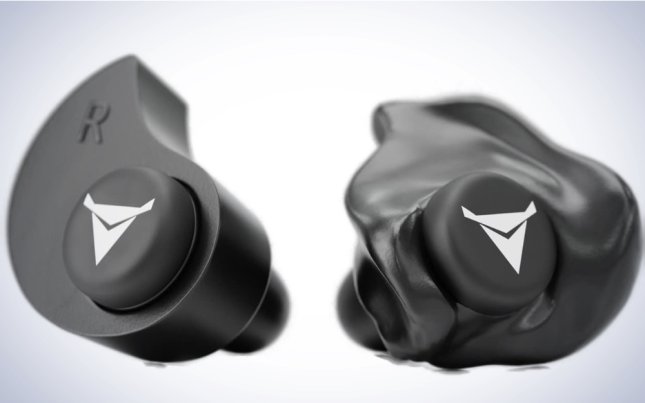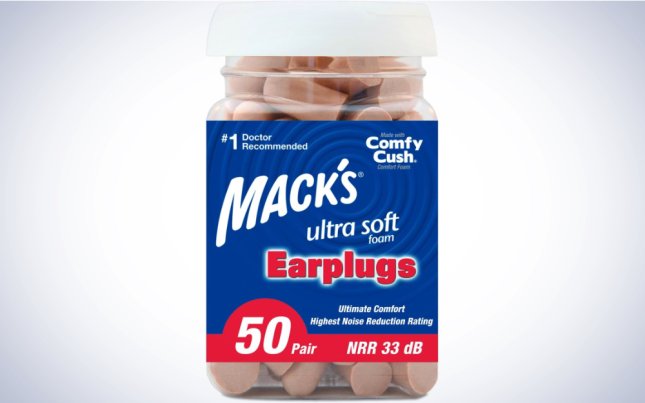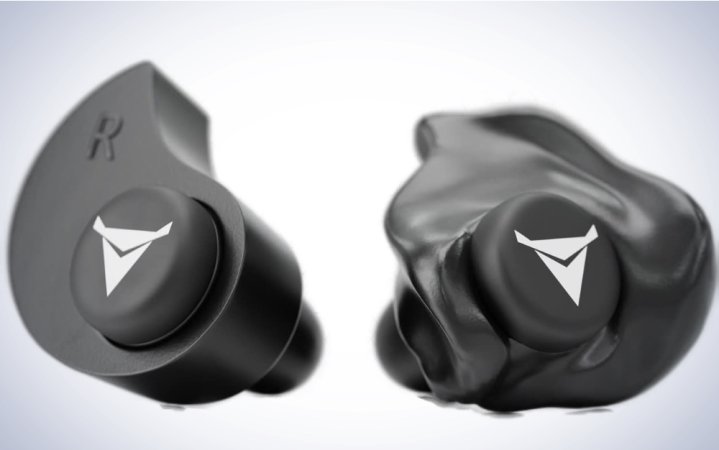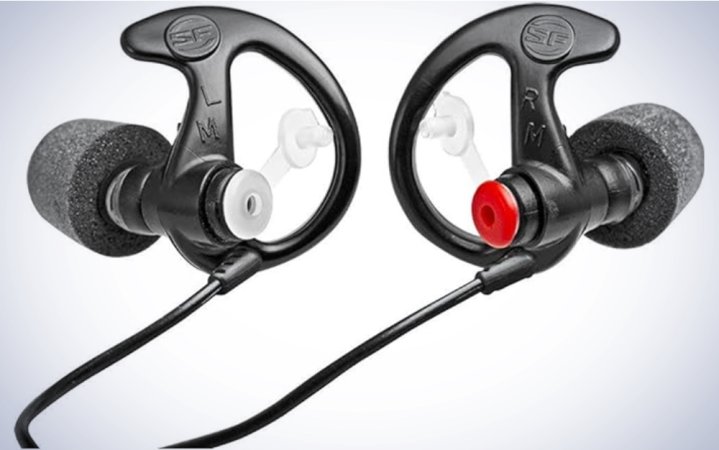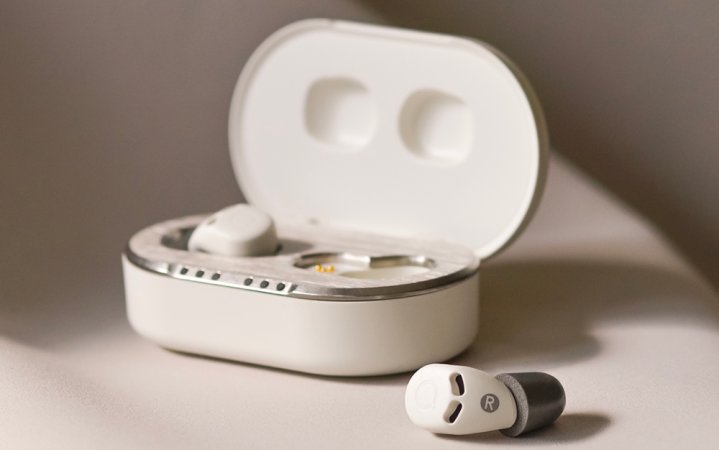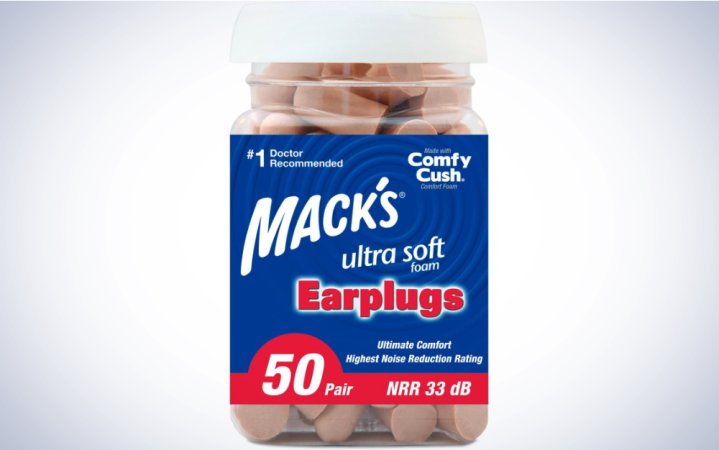We may earn revenue from the products available on this page and participate in affiliate programs. Learn more ›

According to the Centers for Disease Control and Prevention (CDC), 22 million workers are exposed to potentially damaging noise at work each year, which means a lot more people should be using earplugs for work. When it comes to noise-induced hearing loss, there’s no reset button. The damage can be gradual, creeping up over decades, or it can happen in an instant after, say, an explosion or even a loud rock concert. Once your hearing is compromised, it’s compromised for life. We chose the Minuendo model as our best earplugs for work, but everyone’s needs and situation are different so check out these options we’ve tested and considered.
- Best overall: Minuendo
- Best custom-molded: Decibullz
- Best for industrial applications: SureFire EP7 Sonic Defenders Ultra
- Best noise-canceling: QuietOn
- Best budget: Mack’s
How we chose the best earplugs for work
Fortunately or unfortunately for the reviewers here at PopSci, urban environments are incredibly noisy places that present endless opportunities to evaluate hearing protection. (In fact, the UN has declared urban noise pollution a top environmental threat, impacting both physical and mental health.) We compared our own experiences using earplugs, including many of the products here, in various scenarios: working in offices, commuting, attending concerts, and even sleeping. It’s difficult to measure the actual attenuation level offered by earplugs without specialized equipment, so we relied on the provided specs and anecdotal experience for that. However, we were able to evaluate fit, comfort, and usability across a range of ear shapes and sizes, keeping in mind the risk factors that may be encountered on job sites.
How loud is too loud?
Noise-induced hearing damage results from sudden acoustic trauma or chronic exposure to high sound levels. The general rule is the louder the sounds and the longer the length of exposure, the greater the risk of hearing loss.
Sounds at or below 70 decibels are generally considered safe; repeated or extended exposure to sound above 85 decibels can cause hearing loss. For perspective, here are the decibel ratings of some common sounds:
- Leaves rustling: 20 dB
- Normal conversation: 60 dB
- Hair dryer: 90 dB
- Emergency vehicle siren: 120 dB
- Gunshot: 140 dB
OSHA requires employers to implement a hearing conservation program when noise exposure is at or above 85 decibels over 8 hours. If you have to raise your voice to be heard by someone three feet away, noise levels might be above 85 dB. For a more scientific way to gauge the noise levels around you, download a free app like the Sound Level Meter App from the National Institute for Occupational Safety and Health (NIOSH).
The best earplugs for work: Reviews & Recommendations
The good news is that noise-induced hearing loss is preventable. Ear protection can cost pennies or thousands of dollars, but perfectly effective choices are available in every price range, as we’ll show you in our guide to the best earplugs for work.
Best overall: Minuendo
Minuendo
Pros
- Stepless, adjustable sound attenuation
- Flat attenuation for balanced, natural sound
- Eleven tip sets fit just about any ear
Cons
- Stepless level control can feel imprecise
Specs
- Attenuation: 7–25 dB
- Material: Silicone tips
- Storage: Zip-close hard plastic case
- Price: $137
Minuendo silicone earplugs are touted as the first passive (non-electronic) earplugs that offer “stepless” sound attenuation, offering seamless, nuanced adjustment to any level between -7 dB and -25 dB. Minuendos feature a detachable cord and magnetic backs that clasp the earplugs together, making it easier to keep track of them. Eleven sets of tips—including foam, silicone, and flanges—fit just about any ear out there, so you can dial out distractions and focus on your task(s). Wipe clean with water or alcohol.
And if you don’t need the more conversational or quieted ends of the spectrum, save $50 and pick up the single setting, 17 dB attenuating Minuendo LIVE with its distinctive copper faceplates. Or, if you want to spend less but like the idea of adjustable attenuation and don’t mind swapping out small parts, also consider the ultra-comfy Sennheiser SoundProtex Plus, which features a two-stage filter design with swappable caps that reduces both high- and low-frequency levels while maintaining clarity so that you can catch just the right amount of office gossip or bandmate soloing. (Read our full profile of those in our guide to the best earplugs for concerts.)
Best custom-molded: Decibullz
Pros
- Remoldable thermoplastic allows repeat fittings
- Bluetooth headphone option
- Available in six colors
Cons
- Hot plastic can feel uncomfortable during molding process
Specs
- Attenuation: 31 dB
- Material: Plastic flange and foam tips
- Storage case: Pouch included; zip-close hard case available
- Price: $25.99
Earplugs that form a perfect seal in your ear provide the best protection against loud sounds, but that was easier said than done for a long time. It used to be that if you wanted custom-molded earpieces like the in-ear monitors musicians wear onstage, you’d have to shell out hundreds if not thousands of dollars and pay a visit to an audiologist. And the best earplugs (so to speak) for performers and mix engineers and audiophiles remain bespoke acrylic sets like the UE Premier, as they provide impeccable isolation from kick drums to commutes while facilitating low-level, high-detail listening.
Your work, however, might involve blocking out the venue but not kicking out the jams. Thankfully, advances in thermoplastics have made it possible to do your own fittings at home for a fraction of the cost and time. That’s why we love Decibullz Custom Molded Earplugs: With Decibullz’ Easy Shape System, simply heat molds in boiling water, let them cool for a few seconds, then insert them in your ear. Don’t panic if you don’t get it right the first time; they’re remoldable. The end result fits and fills the concha, while three sets of triple-flange tips and one set of foam tips are provided for the ear canal, combining multiple layers of isolation.
The company’s Safe + Sound Wireless Earphone Conversion Kit brings Bluetooth audio to Decibullz, plugging directly into the earplugs to convert them into headphones. Safe+ Sound features Qualcomm chips with aptX HD high-definition audio and allows up to 15 hours of continuous use with USB fast charging.
Best for industrial applications: SureFire EP7 Sonic Defenders Ultra
Pros
- Removable filter cap lets you hear full sound
- Compatible with radio comms systems
- Available in three sizes
Cons
- May need to supplement with earmuffs in extreme environments
Specs
- Attenuation: 28 dB (adjustable)
- Material: Medical-grade polymer foam tips
- Storage: Snap-close hard carrying case
- Price: $21.99
SureFire’s Sonic Defenders earplugs line is designed for tactical professionals, industrial workers, and shooting enthusiasts. We like EP7 Sonic Defenders Ultra earplugs, which protect your hearing in demanding environments without interfering with your ability to hear safe sounds. Their foam-tipped stem design, featuring soft memory-foam tips, provides a Noise Reduction Rating (NRR) of 28 dB. Snap-on/off filters let users switch between attenuated sound and normal sound levels, making them easier to use with a phone or headset. Their low-profile design fits under hats, helmets, and supplemental muffs, and patented EarLock retention rings feature seven contact points that lock the earplugs in place for all-day comfort. EP7 Sonic Defenders Ultra are available in black, clear, and orange and include a lanyard and carrying case.
A note about ear protection for industrial jobs: Extreme environments call for the highest sound attenuation. According to NIOSH, the maximum NRR for earplugs is -33 dB; earmuffs top out at -31 dB. Combining earplugs and earmuffs can offer an NRR protection level up to -36 dB. Note that the NRR system can sometimes overestimate the hearing protection provided during typical use; if you’re subjected to noise levels that require very high sound attenuation, consult your employer for best practices and resources.
Best noise-canceling: QuietOn 3.1 Sleep Earbuds
Pros
- 28-hour battery life
- Comfortable enough to sleep in
- No wireless setup required
Cons
- No Bluetooth connectivity
Specs
- Attenuation: 30 dB
- Material: Memory foam tips
- Storage: Hard plastic charging case
- Price: $289
Earplugs and some earbuds serve similar purposes in reducing ambient sound, but they work in different ways. Most earplugs and lower-priced wireless earbuds rely on passive noise isolation, physically blocking the ear canal to prevent external noise from entering. Noise-canceling earbuds, meanwhile, use active noise cancellation (ANC), a system of tiny microphones and speakers that detects ambient sound and generates sound waves that cancel it out. (For this reason, ANC earbuds require power, usually decreasing the run time of the earbuds’ rechargeable batteries.)
QuietOn 3.1 Sleep Earbuds fall into the former category, but unlike other ANC earbuds, which tend to have bulky housings that extend way outside the ear canal, these tiny wonders measure just 20mm end to end. (Billed as the “world’s smallest ANC earbuds,” QuietOns are a third of the size of Apple AirPods Pro.) This makes sense since, technically, they’re designed for sleeping.
ANC technology doesn’t process information fast enough to protect your ears from sudden explosive sounds, but it can do an even better job attenuating low frequencies than traditional earplugs. If you feel like nerding out, check out QuietOn’s comparison chart.
QuietOn 3.1 comes with foam tips in four sizes, a USB-C cable, and a charger case. Built-in lithium-ion batteries last 28 hours on a single charge, and a fully charged case will juice the earbuds for a week. Note that, unlike noise-canceling earbuds, QuietOns do not offer Bluetooth functionality, so you can’t use them to talk on the phone or listen to music, so they might not be the best choice to keep you in the zone at the gym. But they’ll make up for that in peaceful nights and productive days.
Best budget: Mack’s Ultra Soft Foam Earplugs
Pros
- Inexpensive
- Ideal for a range of applications
- Comfortable for sleeping
Cons
- Not reusable
Specs
- Attenuation: 33 dB
- Material: polyurethane foam
- Storage case:
- Price: 100 for $40
In the realm of budget-friendly hearing protection, Mack’s cheap, disposable foam earplugs reign supreme. While Mack’s makes a huge range of foam earplugs for everything from swimming to sleeping to air travel, the all-purpose Ultra Soft Foam Earplugs are our favorites, offering a steep 33 dB of sound attenuation at a staggeringly low price. Their soft, pliable foam molds gently to the contours of your ear canal, providing a snug seal that effectively blocks out unwanted noise. Their low-profile design easily fits under helmets and hats and provides a comfortable, secure fit for long-term wear. The earplugs in this 100-pair package are individually wrapped, making it a cinch to throw pairs in your purse, gym bag, glove compartment, and carry-on so they’re always at the ready. You can pick up a jar of 50 loose pairs for $14.99 if you prefer a more sustainable option.
For a stylish, reusable alternative, check out the ultra-cushy, washable Loop Engage, which offers a modest Noise Reduction Rating of 10 dB sound attenuation, letting you take the sonic edge off while still participating in conversations, or the Loop Quiet with its mid-level NRR 14 dB noise reduction.
What to consider when choosing the best earplugs for work
When selecting the best earplugs for work, the most important factors are Noise Reduction Rating, durability, hygiene, and ease of insertion/removal. In industrial environments with high noise levels, prioritize earplugs with a higher NRR and durability, while in office settings, comfort and ease of use may be more important—after all, the best earplugs are the ones you’ll actually keep in your ears. If you work in an industrial setting, it’s critical to ensure compatibility with other safety equipment, communication needs, established safety standards, and regulatory compliance.
FAQs
Yes, it’s generally safe to wear earplugs at work, and earplugs can be required in work environments with high noise levels. However, consider communication needs or safety requirements specific to your job.
Silicone and foam earplugs are both effective. Foam earplugs provide a tighter seal than silicone, which can lead to more robust sound attenuation, but they must be inserted correctly, deep within the ear canal. Silicone earplugs don’t need to be inserted as far into the ear canal, which tends to make them easier to fit and wear. Foam earplugs are considered disposable since they collect bacteria with re-use; because silicone earplugs can be repeatedly washed and reused, they can be a more sustainable choice.
Earplugs are designed to fit snugly in the ear canal without reaching the eardrum. However, improper insertion or using earplugs that are too large may increase the risk of accidental insertion deep into the ear canal. It’s important to follow instructions and choose earplugs of an appropriate size to minimize this risk.
Earplugs don’t silence all sound; they reduce sound to a safe level. When you wear earplugs, some sound may still penetrate, especially if the earplugs have a lower Noise Reduction Rating (NRR) or are not inserted properly. And certain earplugs are designed to attenuate noise without completely blocking it out to maintain situational awareness or facilitate communication in the workplace.
You’ll never experience complete silence with earplugs. You’ll always perceive some sound, even when you wear earplugs with the highest NNRs, because the bones in your skull conduct sound vibrations to your eardrum. And when you block the ear canal, the sounds you produce when talking, breathing, and chewing can become amplified, known as the occlusion effect.
Final thoughts on the best earplugs for work
- Best overall: Minuendo
- Best custom-molded: Decibullz
- Best for industrial applications: EP7 Sonic Defenders Ultra
- Best noise-canceling: QuietOn
- Best budget: Mack’s
When it comes to finding the best earplugs for working, consider your daily grind and what keeps you in the zone. If you’re clocking hours in a bustling office, a pair of reliable earplugs can drown out distractions like chatty coworkers or the hum of office machinery, letting you focus on the task at hand. In industrial settings, durable earplugs are your silent allies, guarding against the roar of heavy machinery and protecting you from serious injury. And if your workday seeps into your personal time, versatile earplugs can transition from the office to the coffee shop to bed, ensuring that you’re always in control of your auditory environment. Whatever your work entails, investing in the best earplugs for to your needs is a sound decision that pays off in productivity and peace of mind.

